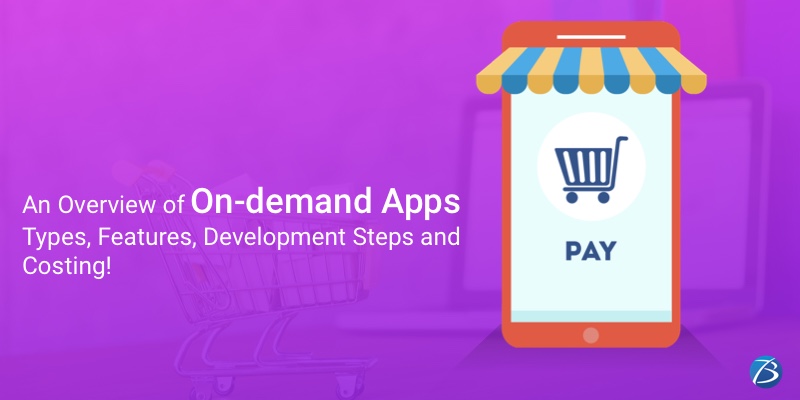
The first on-demand app model was designed for Uber- the world-famous taxi booking app. Who knew that this concept of delivering services on-demand to the customer would make the business world go crazy?
Many ask whether this is just a bubble. Whether is this just a short-term trend? Will this trend slow down soon?
But today, these fast, reliable, and user-friendly on-demand apps are present everywhere. The on-demand economy has disrupted almost every business sector whether grocery, healthcare, home renovation, and many more, and there is no sign of stopping.
So, if you want to gain detailed insights about it or want to know how to approach the creation of a futuristic on-demand app, this article is for you. Here, I have discussed the on-demand app types, working, features, pricing, the development process, and much more. Let’s dive deeper into the topic.
How does an On-demand Application Work?
- Consumers place a request for the products/services they want
- The app then connects the consumers with the concerned service provider
- The service provider looks over the consumer request and accepts it
- Consumer confirms the address, contact details, cost of the service, etc.
- Payment is authorized.
- The service provider delivers the product/service.
- The consumer does the payment if the ‘Cash-on-delivery’ option was selected
Types of On-demand Apps in the Market with Examples
Taxi and Travel-related Apps:
This domain has benefitted the most from the on-demand economy. Giant players like Uber, Lyft, Curb, Free Now, Airbnb, Booking.com, etc., are helping the users to avail the taxi services using their smartphones.
Food Delivery or Restaurant Apps:
Using these apps, the users can order meals from their favorite eateries nearby. These apps help restaurants to expand their customer base online. UberEats, GrubHub, Doordash, Zomato, etc. the well-known examples of these apps.
Healthcare Services On-demand Apps:
Healthcare apps like Doctor on-demand, IsDocin, Medicast, Phlex65, etc. are some of the on-demand healthcare apps that help patients to hire doctors, physicians, caregivers, or even order medicines online.
Home Services Apps:
Applications like TaskRabbit, Thumbtack, UrbanClap i.e. Urban Company, Merry Maids, etc. are being widely used for hiring services or individuals for carrying out tasks like household chores, dog walking, repairs, plumbing services, etc.
Grocery Apps:
Now people can easily purchase groceries using the apps like Instacart, Amazon Fresh, Walmart, Dumpling, Shipt, etc., and get them delivered to their homes. The usage of these apps has sky-rocketed, especially during the pandemic.
Other On-demand Apps:
Other examples include Treatwell- for salon services nearby, SweatFlix- for exercising and fitness classes, BloomThat- flower delivery services, Starz- an app for downloading movies, shows, etc.
Key Features of an MVP Model for the On-demand Apps
Before hiring an on-demand app development partner, it is always better to decide the potential features to be included in the app. Here I have mentioned are the MVP features required for creating a basic but impactful version of the app. Since there are three versions for any on-demand app, viz. customer app, service provider app, and Admin app, I have accordingly jotted the features.
Customer Version
- Simple Registration and Profile Creation
- Push Notifications
- GPS Tracking
- Flexible Online Payments
- Feedback and Rating System
- Support and Customer Care Services
Service Provider’s Version
- Simple Registration and Profile Management
- Buttons for Accepting/Rejecting Orders
- Push Notifications
- Button for Online/Offline Status
- Dedicated Page for Earnings
Admin’s App Version
- Admin Dashboard
- Accessibility to Customer’s and Service Provider’s Data
- Authority to Change Rates and Fees
- Analytics and Reports
Significant Steps for Architecting a Top-class On-demand Application
Do Your Research
Before getting into the development straight-a-way, it is of paramount importance to do your research well. Research helps you know your target audience better, their preferences, behavioral patterns, etc. Also, research about the ongoing trends, competitors, etc.
Pick the Desired Features and the Relevant Technology Stack
Decide the features you want in your app; you can refer to the above-mentioned list of features for this. But, it is essential to include at least the basic features like registration, GPS, payment, notifications, etc. in the app.
Also, pick the right technology stack for frontend development, backend development, database, web or native (iOS/Android platforms), or cross-platform development, etc. as per your budget.
Hire the Right Development Firm
Finally, it is time to either hire an in-house development team if you are looking for a long-term project or you may even look for an offshore app development company for the project.
Estimated On-demand App development Cost and Pricing
Predicting the exact price for an on-demand app is a tedious job because every project has different specifications and requirements. Besides, the price is affected by various factors like design complexity, features to be embedded, technology stack, platform/s selected, the development team working on the project, etc. So, here I have roughly bifurcated the cost of an on-demand application, take a look.
- An on-demand app with the fundamental features can range from $20,000 to $40,000.
- An app with a few moderate features can cost anywhere from $40,000 to $70,000.
- A full-fledged on-demand app with several advanced and robust features could approximately cost from $70,000 to $150,000 or so.
Final Words:
Needless to say, on-demand delivery apps are the future. They have offered unimaginable flexibility to the consumers for availing a wide range of services, from the very comfort of their homes and this flexibility has made them addicted to these apps. Besides, this economy has empowered diverse businesses and helped them expand their horizon.
So, when are you leveraging the on-demand economy?
Do comment here and let me know your thoughts on this.
Also, share your experiences in case you have already developed on-demand app projects.
